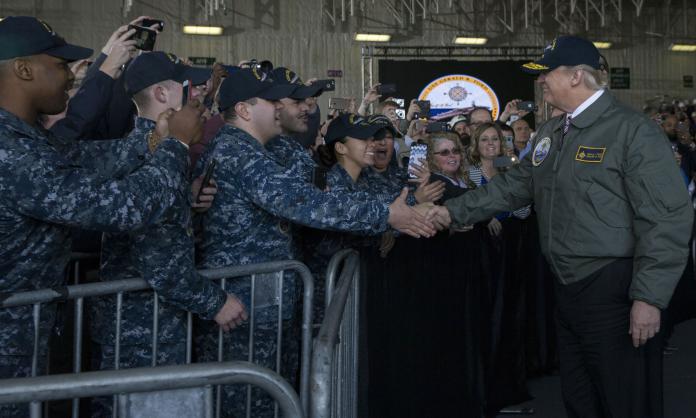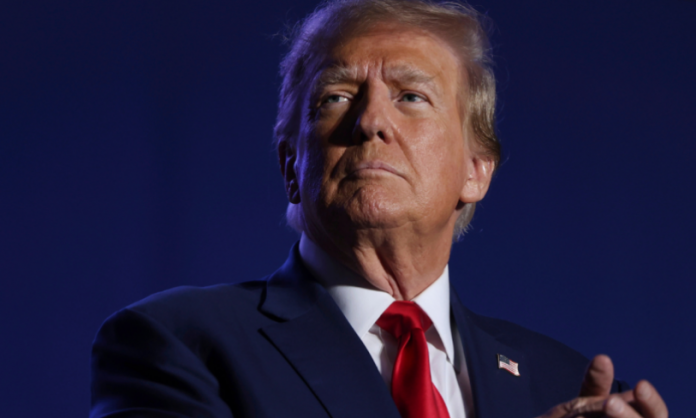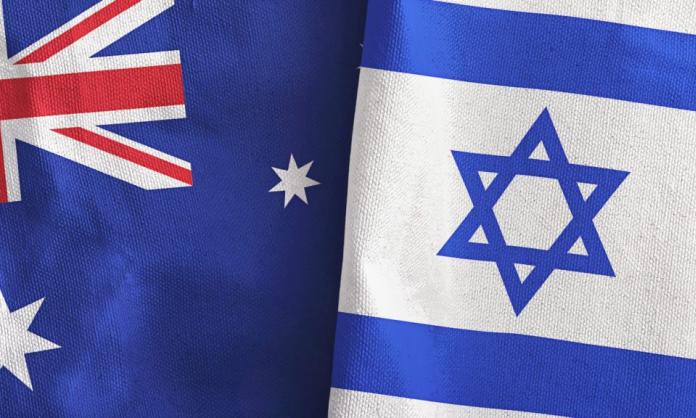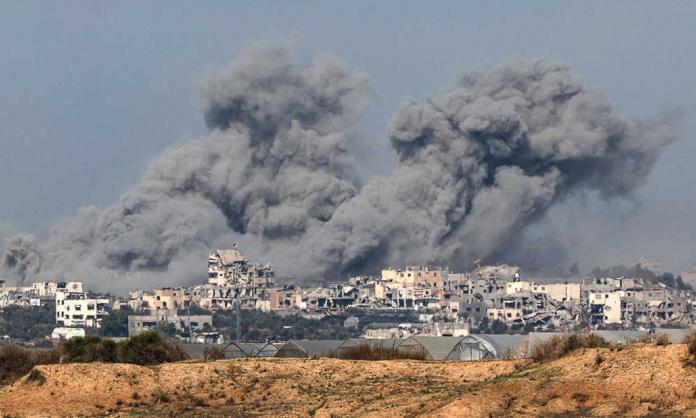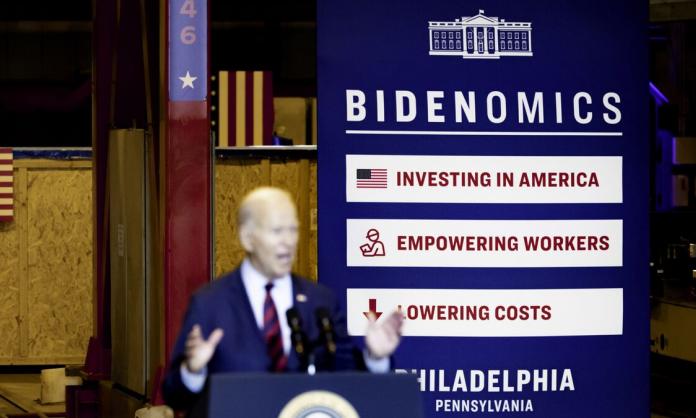Italian sociologist Giovanni Arrighi defined “hegemony” as the influence a country accumulates not simply from using power to advance its own interests, but by its leadership being in the perceived interests of the countries that fall in behind it. Under Donald Trump, it is precisely this waning influence that the US establishment worries about.
US decline in the last decade and a half has in some ways been remarkable. Yet it is far from interminable and indeed may be reversing. The source of US hegemony for much of the 20th century was mutual agreement among its competitors that the US was a lesser evil than the alternative. With the end of the Cold War, that logic ceased to be operative in the calculus of geopolitics – the US was more powerful than ever, but there were fewer reasons for other states to view its leadership as necessary or vital. That in itself was partly the undoing of US hegemony. But if the world is now returning to the logic of cold war, we should expect to see a new form of Western coalition coalescing around the US, one that has been absent in the last two decades.
In the aftermath of World War Two, the globe was ordered around the rivalry between the Western capitalist bloc led by the United States and the Stalinist Eastern bloc and its allies, led by the Soviet Union. The latter’s authoritarian command economies grew rapidly but were unable to match the labour productivity of the West. The Soviet Union therefore protected itself behind the Iron Curtain of border controls that limited the movement of people and goods. It engaged in economic competition only indirectly, through military build-up.
The Western order was more flexible, an architecture of treaties and transnational institutions to promote open markets and bring together the largest possible anti-Soviet alliance. The International Monetary Fund, the World Bank and the North Atlantic Treaty Organization were all established to construct, support and project liberal capitalism against the state-directed development of the East. Another aspect of this project was Western European integration, which began with the Treaty of Paris in 1951. In practice, the Western order reinforced the power of the US globally and, over time, of Germany within Europe. US hegemony was decisive for maintaining and deepening multilateralism; and it provided a military umbrella under which other Western economies developed rapidly, Germany and Japan in particular.
One of the most important pillars of the Western order was the Bretton Woods exchange-rate system, established in 1944, which linked currencies to the US dollar, and the dollar to gold. For several decades, Bretton Woods provided stability and certainty in global trade. But the pegged exchange-rate arrangement collapsed in 1971, when US gold reserves became insufficient to honour the country’s debts, which were rising as the postwar economic boom entered its twilight and as the war against Vietnam exacted a mounting toll on the balance of payments. Financial speculation in the West, previously constrained under Bretton Woods, was progressively unleashed as a new era of globalisation was orchestrated. “The basis of American hegemony was being shifted from one of direct power over other states to a more market-based or ‘structural’ form of power”, noted political scientist Eric Helleiner.
In this period, many of the world’s ruling classes, particularly those in Western Europe, viewed US leadership as vital to capitalist prosperity and Soviet isolation. The implosion of the Eastern bloc in 1989-91 vindicated the US approach in the eyes of ruling classes everywhere. Very few now repudiated the economic model advanced by Washington. One of the foremost cheerleaders of US supremacy was conservative columnist Charles Krauthammer, who wrote at the time:
The most striking feature of the post-Cold War world is its unipolarity. No doubt, multipolarity will come in time. In perhaps another generation or so there will be great powers coequal with the United States ... But we are not there yet, nor will we be for decades. Now is the unipolar moment ... a single pole of world power that consists of the United States at the apex of the industrial West ... American preeminence is based on the fact that it is the only country with the military, diplomatic, political and economic assets to be a decisive player in any conflict in whatever part of the world it chooses to involve itself.
The US ruling class hoped that Eastern Europe could be brought into the Western fold and that Russia would be isolated. The National Security Strategy documents issued by consecutive presidents – Bill Clinton (1993-2000), George W. Bush (2001-08) and Barack Obama (2009-16) – pressed the case for an expanded Western alliance. All spoke of international institutions and obligations, free trade, free markets, democracy and individual rights. This rhetoric was premised on the reality that the world’s largest global corporations were headquartered in the West and reaped the benefits of open markets, which allowed them to exploit cheap labour, extract natural resources and sell their products around the world. For a time, optimism reigned within the Western camp. Germany reunified. The Treaty on European Union was signed in 1992, and the US entered the years of the so-called New Economy – one of the longest and most robust expansions in its history.
But the Soviet collapse had changed the equation; the unipolar moment and the good will didn’t last. First, the Bush administration’s geopolitical unilateralism after the 9/11 attacks in 2001 showed that Western Europe would not simply follow US “leadership” in the post-Cold War era. The White House was left denouncing “old Europe”, as its grand Coalition of the Willing mustered just four countries to join its Iraq invasion force in 2003. The longer list of supporters contained such hefty territories as the Marshall Islands, Micronesia, Palau and the Solomon Islands, none of which had their own armies. “We’re an empire now, and when we act, we create our own reality”, one senior White House adviser told journalist Ron Suskind in 2004. But instead of underlining US power, the invasions and subsequent occupations of Afghanistan and Iraq undermined it.
Second, the neoliberal model of US financial supremacy – the “market-based form of power” – suffered a crisis of its own excesses. For years, capital flowed from the rest of the world into US interest-bearing bonds, which helped underwrite the country’s military expenditure and domestic purchasing power. The US was able to spend more than it earned. But economic growth was dependent on the ability of financial markets to price their investments accurately and spread the risks associated with them. Asset-price collapses, beginning in property markets in 2006, exposed the vulnerabilities of the debt binge. When the house of cards came crashing down with the mortgage-backed securities crisis, Western economies entered their greatest spiral since the Great Depression. And they had the US to blame, something that was not lost on US rivals.
Third, Russia’s rulers turned sharply against the so-called reform process of the 1990s. Benefiting from an oil and gas price boom under the dictatorial rule of Vladimir Putin, and capitalising on US weakness, the Russian Federation began to reassert itself militarily, invading Georgia in 2008, annexing Crimea in 2014 and intervening in Syria in 2015. To US chagrin, Western European dependence on Russian energy supplies again left Washington with few friends when it wanted to turn the screws on Moscow. Finally, and most importantly, the global economy reoriented toward East Asia – the most profound shift in the world balance of power since the collapse of the Soviet Union.
The overriding assumption of an expanding US-led Western order was the continuing primacy of the US in the broader international economy. As Krauthammer noted, unipolarity would always be temporary: “If America succeeds in running its economy into the ground, it will not be able to retain its unipolar role for long. In which case the unipolar moment will be brief indeed (one decade, perhaps, rather than, say, three or four)”. It certainly didn’t make three. While the decline of US power is relative, not absolute, the limits of US imperialism are particularly apparent in its paranoia about China’s development. As economic historian Adam Tooze noted recently in the London Review of Books:
One of the effects of America’s unipolar dominance in the wake of the Cold War was that it permitted a clean line to be drawn between economic and security policy. Economic growth powered by globalisation was geopolitically innocent. In the best case, as liberals hoped, economic development would produce political and legal convergence ... The scale of China’s growth, combined with the determination of its political leadership, has undone the notional separation of economics and security policy entirely. The reason that a large part of America’s elite is deeply concerned about China has nothing to do with trade imbalances or blue-collar jobs. What matters is the sheer weight of state power conferred on Beijing by China’s spectacular economic growth. As far as America’s hawks are concerned, every dollar added to China’s GDP, every piece of technology that China acquires, shifts the geopolitical balance in the wrong direction.
The election of Donald Trump four years ago reflected the US decline. It’s almost inconceivable that such a man, or at least, such a campaign as he headed in the presidential race, could have been successful in a confident imperialist state. That’s precisely what unnerved the president’s establishment detractors: not Trump himself, but the reality his candidacy exposed. If Trump loses the next election, State Department celebrations will be short lived – the problems of empire will remain.
Yet while the calamities of 21st century US imperialism and the shifts in the global economy have cast doubt on the US capacity to be a hegemon, ironically, the country’s relative decline may inject a new lease of life into its leadership. The Chinese Communist Party’s assertiveness, and its success in building its own coalition of partner states, is causing disquiet not only in Washington. And the US remains the only power capable of stifling China’s rise. It is the clear leader in international finance – more than 60 percent of the world’s currency reserves are denominated in dollars, more than 40 percent of cross-border payments are dollar-based, much of the international debt markets is dollar based, and as the pandemic has again shown, when there is a major international crisis, global capital flight has one overwhelming destination: US Treasury bonds. No other currency, and therefore no other financial system, has such power not only to enrich but to sanction. No other country has such dominant technological power. And no country comes close to its military eminence.
The cheerleaders of unipolarity several decades ago got well ahead of themselves. It would be a mistake to go too far in the other direction and proclaim the end of US dominance. The joke that was the Coalition of the Willing in 2003 will not be repeated in the growing confrontation with Beijing. Indeed, don’t be surprised if we see a renewed US hegemony within a growing anti-China bloc. That group need not be even a plurality of states. The often overlooked part of the Cold War was that the formally nonaligned and neutral bloc represented a greater number of states, and people, than either of the Western or Eastern alliances. But the Western bloc under the US didn’t need the formal allegiance of all these underdeveloped economies, many of which became dollar dependent anyway – the key imperialist states combined in the anti-Soviet alliance were enough, in the end, to crush the Eastern bloc.
China’s great strength compared to the Soviet Union is that it is at the heart of the global economy, rather than shut off from it. That has enabled it to build relationships with other ruling classes based on mutual economic advantage, sometimes real, sometimes perceived, the way the US has for decades. But that centrality to the world economy is also, as some of China’s leading companies are finding out, a source of great vulnerability as pressure mounts against it. It is precisely China’s strength that could push otherwise ambivalent countries into the sphere of the US in a dynamic Washington could not generate when it embarked on the project for a new American century. When that happens, the world may again talk about US hegemony and empire.




